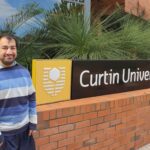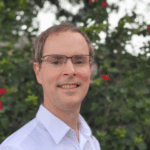Chancellor, Vice Chancellor, fellow graduates, ladies and gentlemen I thank Curtin University for this great honour.
At last I have become a real doctor!
This is a particularly auspicious occasion because my wife, Suzie, is also a Curtin graduate. We have a collegiate affection and high regard for this great university.
I have a deep interest and passion for the visual arts, especially contemporary Australian art. By giving away artworks under the Cultural Gifts Programme, I can share this passion and this is a great source of satisfaction.
Perth is a glittering city and the capital city of Western Australia, a vast and wealthy State. In spite of our isolation we enjoy a full and rewarding Cultural life especially at a time like the present with our international festival of arts.
However with regard to the visual arts we do have a glaring deficit. In our State collection at the Art Gallery of Western Australia we have no major European art at all.. we have no Titians, no Tintorettos. We have no Rembrandts nor Rubens, no Constables no Turners. Not one Cezanne and no Picasso. For a major capital city this is a serious artistic hiatus.
But this gap is filled in a most remarkable way. At this time the very best art anywhere in the world is being created right here in Australia and particularly in Western Australia!
I refer of course to the amazing renaissance of art created by Indigenous Australian artists starting in Papunya in the Northern Territory in the early seventies and I’m sure you will recall great Pintupi artists such as Clifford Possum Tjapalltjari and Johnny Warangkula Tjupurulla possibly Australia’s greatest artist.
This astonishing art renaissance spread north to Yuendumu, Lajamanu and Utopia where the amazing old lady Emily Kame Kngwarray painted her vibrant canvasses.
The art movement spread across the border to Western Australia to places as diverse as Warmun previously known as Turkey Creek where our most famous Western Australian artist Rover Thomas worked – he represented Australia in the 1991 Venice Biennale – together with the late Paddy Bedford and Western Australia’s national treasure Queenie McKenzie, sadly also deceased, and on to Balgo where the marvellous Eubena Nampitjin lives and works and to Fitzroy Crossing where we recall Jimmy Pike and the venerable Butcher Cheryl.
But we in the West are even more fortunate because a momentous artistic development has occurred in a vast area beyond Warburton known as the “The Lands” or “The APY lands” over the past 5 years.
Warburton is probably the most remote little town in WA and yet hundreds of kilometres beyond Warburton to the north and east are settlements where great artists work such as Warakuna, Wingelina, Kayili and the Spinifex lands. In my opinion the most exciting Indigenous art of all comes from these areas and in particular from Blackstone Ridge from where a previous recipient of the honour which I have received tonight comes. I refer to Doctor Panjiti Mary McClean. Mary McClean was born at Blackstone Ridge moving on to live in Kalgoorlie. Her sister Elaine Lane and brother Jimmy Donnegan both outstanding Australian artists still live and work at Blackstone.
Robert Hughes, art critic for Time magazine, has described this Australian Aboriginal art movement as the last great art movement of the 20th century and I venture to suggest that it is the first great art movement of the 21st century. Fortunately these great works of art are well represented in our public collections, at both the State gallery and in our University collections.
We are actually doubly blessed ladies and gentlemen because Indigenous art is not just “art for art’s sake”. Each painting tells a story and these stories go back for thousands of years.
This land has a history… this history precedes Governor Stirling. It precedes the arrival of the first fleet and Captain Cook and yet most of us (including myself) know very little about the history of our country. We barely know where Warmun or Wingelina are on the map. We know little about the people who have lived there, their epic journeys and the great deeds contributing to the creation of this land.
My main message in this Occasional Address is a call to our educators to introduce the study of Aboriginal culture, history and art as a compulsory subject in our schools. What better way to study history than to look at art?
Ultimately it is only by absorbing this Australian culture as our own and sharing our cultures that we can achieve reconciliation.
In conclusion while this university is known as the Curtin University of Technology, it has an outstanding and vibrant Art Gallery under the directorship of Professor Ted Snell. While the sciences further our knowledge of the universe,the arts explore the relationship we have as human-beings to this knowledge and to each other. The yin and the yang, a perfect balance.
I would like to thank Ted for everything that he has done towards the great honour that I’ve received tonight, for his enthusiasm and friendship. Ted is a great facilitator. Like the Hindu Deity Ganesh he removes obstacles and makes things happen.
I’d also like to thank my very good friend and colleague Dr. C.T.Tan, who is on the John Curtin Gallery Advisory board, for his contribution to the events of tonight.
Finally I’d like to acknowledge my wife,Suzie. We’ve been together for more than 40 years and I think you’re lovelier than ever.
Thank you very much.


